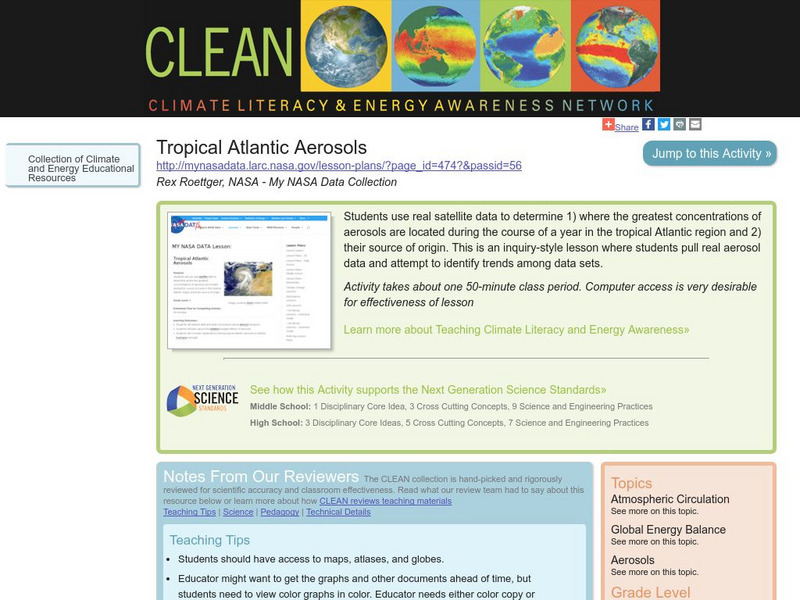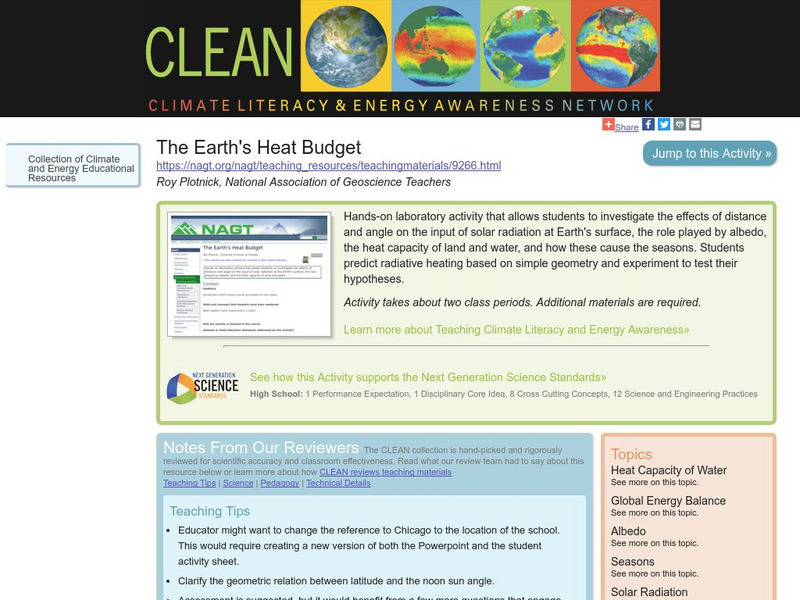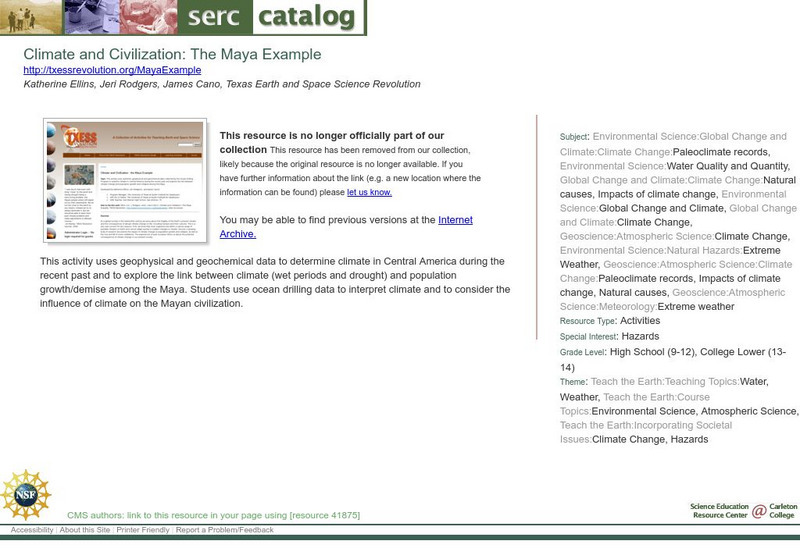Climate Literacy
Clean: Climate Change and Disease
Students research the relationship between hosts, parasites, and vectors for common vector-borne diseases and evaluate how climate change could affect the spread of disease.
Climate Literacy
Clean: Climate Change and Ecosystems
Students research the inter-dependencies among plants and animals in an ecosystem and explore how climate change affects those relationships and the ecosystem as a whole.
Climate Literacy
Clean: Colorado River Supply
Students examine available data of water in the Colorado River Basin, study the possible consequences of changes to various user groups, and suggest solutions to adapt to these changes.
PBS
Pbs Learning Media: Global Climate Change: The Effects of Global Warming
Students conduct an investigation to determine CO2 levels in four different gas samples, examine evidence of global warming in our environment, and consider their own role in contributing to global warming.
Climate Literacy
Clean: Person on the Street (Pos) Interview About Climate Science
A media project where young scholars create a video that documents unrehearsed interviews with "people on the street" about a specific question or issue in climate science.
Climate Literacy
Clean: Ocean Impacts on an El Nino Event
Students examine the relationships among sea surface height, sea surface temperature, and wind vectors in classifying the ocean characteristics of an El Nino.
Climate Literacy
Clean: Impacts of Topography on Sea Level Change
Students use web-based animations to explore the impacts of ice melt, specifically changes to sea level. They also use topographic maps to examine the relationship between topography and sea level change by mapping changing shorelines.
Climate Literacy
Clean: Sea Level Rise
Students will learn the difference between sea ice and glaciers in relation to sea level rise using topographic maps.
Climate Literacy
Clean: Tropical Atlantic Aerosols
Students will use real satellite data to determine where the greatest concentrations of aerosols are located during the course of a year in the tropical Atlantic region and their source of origin.
Climate Literacy
Clean: Ocean Currents and Sea Surface Temperature
To discover the link between ocean temperatures and currents as related to our concern for current climate change.
Climate Literacy
Clean: Global Patterns in Green Up and Green Down
Young scholars analyze and explore visualizations and graphs that show the annual cycle of plant growth and decline. They investigate several regions in each hemisphere that have different land cover and will match graphs that show...
Climate Literacy
Clean: Temperature and Precipitation as Limiting Factors in Ecosystems
Students correlate graphs of vegetation vigor with those of temperature and precipitation data for four diverse ecosystems, ranging from those near the equator to the poles, to determine which climatic factor is limiting growth.
Climate Literacy
Clean: March of the Polar Bears: Global Change, Sea Ice, and Wildlife Migration
Students use NASA satellite data to study temperature and snow-ice coverage in the South Beaufort Sea, Alaska. With the data, they investigate global change, sea ice changes, and polar bear migration.
Climate Literacy
Clean: The Earth's Heat Budget
Students investigate the effects of distance and angle on the input of solar radiation at the Earth's surface, the role played by albedo, and the heat capacity of land and water.
Climate Literacy
Clean: Global Warming Webquest
Students collaborate as part of a climate action team and learn how society and the environment might be impacted by global warming. Student teams investigate how and why climate is changing and how humans may have contributed to these...
Climate Literacy
Clean: Uptake of Carbon Dioxide From Water by Plants
Two simple experimental demonstrations show the role of plants in mitigating the acidification caused when carbon dioxide is dissolved in water.
Science Education Resource Center at Carleton College
Serc: How Greenhouse Gases Absorb Heat
In this experiment students observe two model atmospheres: one with normal atmospheric composition and another with an elevated concentration of CO2. These two contained atmospheres will be exposed to light energy in a sunny window or...
Climate Literacy
Clean: Climate and Civilization: The Maya Example
Learners use geophysical and geochemical data collected by the Ocean Drilling Program to examine climate in Central America during the recent past. They also have the opportunity to investigate the link between climate change and...
Climate Literacy
Clean: Climographs: Temperature, Precipitation, and the Human Condition
A lesson where students learn how to read, analyze, and construct climographs which display monthly average temperature and precipitation. Students also practice matching climographs to various locations and summarize global-scale...
University Corporation for Atmospheric Research
Ucar: Differences Between Climate and Weather
For this activity, students collect weather data over several days or weeks, graph temperature data, and compare the temperature data collected with averaged climate data where they live.
University Corporation for Atmospheric Research
Ucar: Dendrochronology Trees: Recorders of Climate Change
Learners discover how tree age can be determined by studying the rings, and how ring thickness can be used to deduce times of optimal growing conditions. Then they investigate simulated tree rings applying the scientific method to...
University of Colorado
University of Colorado: Signs of Change: Studying Tree Rings
Learners gather information from real tree core samples and compare them with local climate history.
Climate Literacy
Clean: Greenhouse Gas in a Bottle Demonstration
A simple demonstration that is quick and easy to setup and provides dramatic evidence of the effect on temperature of an atmosphere with increased carbon dioxide. [4 min]
Museum of Science
Ei E: Water, Water Everywhere: Lessons: Designing a Water Filters
This unit offers four lessons demonstrating a classroom working on the engineering problem of providing clean water as they imagine, plan, create, test, and improve their own water filters.



















